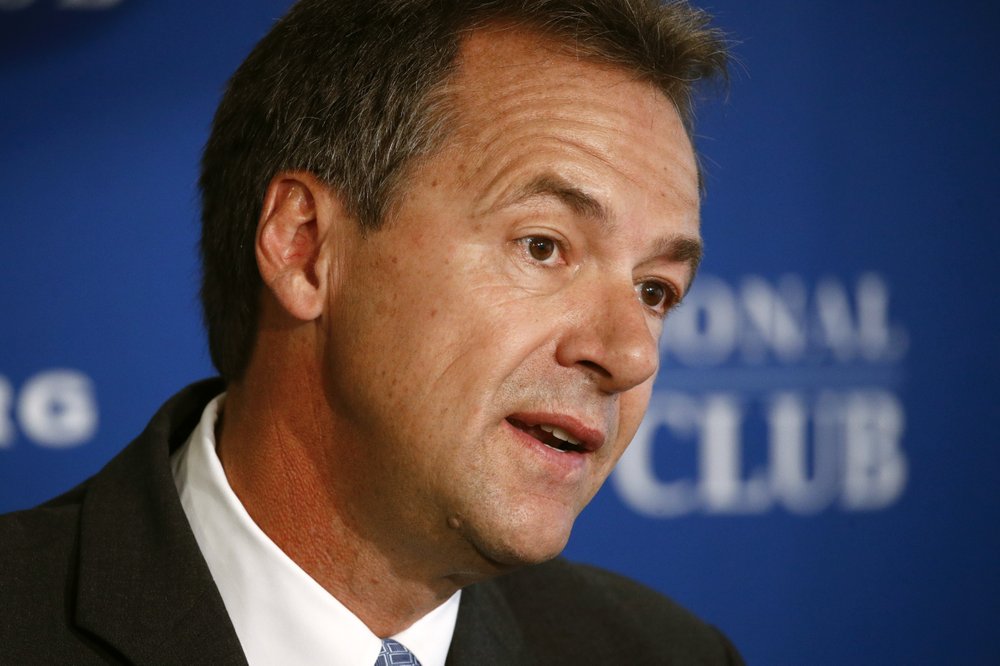Montana Gov. Steve Bullock was told how he could qualify for the next presidential debate, but it didn’t make much sense: Spend $60. Attract a $1 donor. And repeat, maybe thousands of times.
“You spend $60 on Facebook right now to get a $1 donor,” Bullock said last week while campaigning in Iowa, referring to the 130,000 donor threshold that is one of the requirements to reach the debate stage in Houston next month. “I don’t know if I’ll make the threshold.”
He’s not alone. Facing a Wednesday deadline, a handful of Democratic White House hopefuls are racing against time — and odds — to qualify, trying desperately to meet the donor targets as well as reaching 2% in four approved public opinion polls.
New York Sen. Kirsten Gillibrand is pumping millions into online and TV advertising. Billionaire climate change activist Tom Steyer, a late entry to the race, has also spent $3.8 million on Facebook ads trying to boost his name recognition and rapidly add donors.
Others simply gave up — or dropped out.
In a still-crowded Democratic field, with time increasingly running out to break into the top tier of candidates, not qualifying for the debate could doom several candidacies. Still, many have vowed to forge on, hoping that they can reach the requirements before the following debate in October.
“We’re getting to the cutoff point for a lot of lower-tier candidates,” said Tim Lim, a digital strategist and fundraiser who worked on Hillary Clinton’s 2016 campaign. “Folks who are in the bottom half right now, unless they start deficit spending I don’t know how they are going to do it.”
Though earlier debates had lower floors, the Democratic National Committee upped the stakes for the coming two. As of now, 10 candidates have reached the qualifying thresholds on donors and polling. If that holds, the September debate would be the first of the cycle held on a single night.
The DNC designed the requirements to bring order to an unwieldy field of more than 20 White House hopefuls, while elevating the role of online grassroots donors who are among the party’s most fervent supporters. And in some ways they’ve succeeded. But for those candidates who have fallen short, there is an emerging sense of bitterness.
“It forces campaigns to (hand) over millions of dollars to Facebook — the same platform that let the Russians interfere in 2016,” said Colorado Sen. Michael Bennet, who won’t make the September stage and plans to campaign in early voting states instead. “If we wanted to be the party that excluded people, we’d be Republicans.”
Washington Gov. Jay Inslee, former Colorado Gov. John Hickenlooper and Massachusetts Rep. Seth Moulton all recently ended their campaigns as they struggled to qualify. Last quarter, Inslee spent more than the $3 million he raised, much of it funneled into Facebook ads, pleading for donors. He hit the donor mark, but lagged in polling and dropped out last week.
Other than Steyer, no one has spent more than Gillibrand to qualify. She’s struggled since entering the race to gain traction and is keeping her campaign afloat with a $9.6 million transfer from her Senate campaign fund.
During the last fundraising quarter she spent almost twice what she raised, records show. Now she’s plunging even more money into advertising, including a $1.6 million TV ad buy in Iowa and New Hampshire aimed at boosting her polling. She’s also spent roughly $2.1 million on Facebook ads aimed to get new donors over the last 90 days, making her the No. 3 political spender on the platform, behind only President Donald Trump and Steyer during that time, spending data shows.
“I want to be on the next presidential debate stage but I don’t have enough supporters,” Gillibrand says in one recent ad. “Please go to KirstenGillibrand.com. You just have to give $1.”
Last week, her campaign announced it had reached the 115,000 donor mark. They are holding out hope that that the three needed polls — which may not even exist — will be released before Wednesday.
“We expect more polls to be released … and that Kirsten will qualify for the third debate,” said spokeswoman Meredith Kelly. “Kirsten is working hard, traveling and investing on television to be on the stage, so that her voice can be heard.”
Though the rules have helped deplete some candidates’ campaign accounts, they’ve yielded a massive payday for Democratic consultants, with some online fundraising programs costing as much as $90 per dollar raised, campaign aides say. About two dozen consulting firms have collected at least $25 million in payments for online and digital-related services, according to an analysis of campaign finance data that tracked payments made between January and the end of June, when the last fundraising quarter ended. Rates do vary, though, and the appeal of the candidate is an obvious factor in fundraising success.
While it’s hard to tell whether the campaigns would have spent that much without the rules, there is a discernable trend line that shows many candidates increased their spending as the first set of debates in June neared — and trailed off once they qualified.
Tara McGowan, the founder and CEO of ACRONYM, a progressive group that specializes in digital campaigns, said some campaigns need to take a hint.
“You just hope people gain some sense and don’t want to be on this slog,” she said.
(AP)











